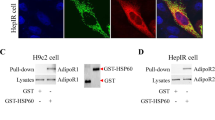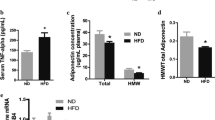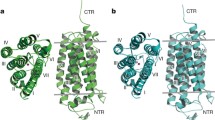Abstract
Adiponectin, a hormone secreted from adipocytes, has been shown to protect against development of insulin resistance, ischemia–reperfusion injury, and inflammation. Adiponectin assembles into multiple oligomeric isoforms: trimers, hexamers and several higher molecular weight (HMW) species. Of these, the HMW species are selectively decreased during the onset of type 2 diabetes. Despite the critical role of HMW adiponectin in insulin responsiveness, its assembly process is poorly understood. In this report, we investigated the role of divalent cations in adiponectin assembly. Purified adiponectin 18mers, the largest HMW species, did not collapse to smaller oligomers after treatment with high concentrations of EDTA. However, treatment with EDTA or another chelator DTPA inhibited the oligomerization of 18mers from trimers in vitro. Zn2+ specifically increased the formation of 18mers when compared with Cu2+, Mg2+, and Ca2+. Distribution of adiponectin oligomers secreted from zinc chelator TPEN-treated rat adipocytes skewed toward increased proportions of hexamers and trimers. While we observed presence of zinc in adiponectin purified from calf serum, the role of zinc in disulfide bonding between oligomers was examined because the process is critical for 18mer assembly. Surprisingly, Zn2+ inhibited disulfide bond formation early in the oligomerization process. We hypothesize that initial decreases in disulfide formation rates could allow adiponectin subunits to associate before becoming locked in fully oxidized conformations incapable of further oligomerization. These data demonstrate that zinc stimulates oligomerization of HMW adiponectin and possibly other disulfide-dependent protein assembly processes.







Similar content being viewed by others
References
Aso Y, Yamamoto R, Wakabayashi S, Uchida T, Takayanagi K, Takebayashi K, Okuno T, Inoue T, Node K, Tobe T, Inukai T, Nakano Y (2006) Comparison of serum high-molecular weight (HMW) adiponectin with total adiponectin concentrations in type 2 diabetic patients with coronary artery disease using a novel enzyme-linked immunosorbent assay to detect HMW adiponectin. Diabetes 55:1954–1960
Basu R, Pajvani UB, Rizza RA, Scherer PE (2007) Selective downregulation of the high molecular weight form of adiponectin in hyperinsulinemia and in type 2 diabetes: differential regulation from nondiabetic subjects. Diabetes 56:2174–2177. doi:10.2337/db07-0185
Bonham CA, Vacratsis PO (2009) Redox regulation of the human dual specificity phosphatase YVH1 through disulfide bond formation. J Biol Chem 284:22853–22864
Briggs DB, Jones CM, Mashalidis EH, Nuñez M, Hausrath AC, Wysocki VH, Tsao TS (2009) Disulfide-dependent self-assembly of adiponectin octadecamers from trimers and presence of stable octadecameric adiponectin lacking disulfide bonds in vitro. Biochemistry 48:12345–12357. doi:10.1021/bi9015555
Burdette SC, Walkup GK, Spingler B, Tsien RY, Lippard SJ (2001) Fluorescent sensors for Zn(2+) based on a fluorescein platform: synthesis, properties and intracellular distribution. J Am Chem Soc 123:7831–7841
Bush AI, Pettingell WH, Multhaup G, d Paradis M, Vonsattel JP, Gusella JF, Beyreuther K, Masters CL, Tanzi RE (1994) Rapid induction of Alzheimer A beta amyloid formation by zinc. Science 265:1464–1467
Chakrabarti P (1990) Geometry of interaction of metal ions with histidine residues in protein structures. Protein Eng 4:57–63
de Orué Ortiz, Lucana D, Wedderhoff I, Groves MR (2012) ROS-mediated signalling in bacteria: zinc-containing Cys-X-X-Cys redox centres and iron-based oxidative stress. J Signal Transduct 2012:605905. doi:10.1155/2012/605905
Dodson G, Steiner D (1998) The role of assembly in insulin’s biosynthesis. Curr Opin Struct Biol 8:189–194. doi:10.1016/S0959-440X(98)80037-7
Dunn MF (2005) Zinc-ligand interactions modulate assembly and stability of the insulin hexamer—a review. Biometals 18:295–303. doi:10.1007/s10534-005-3685-y
Esler WP, Stimson ER, Jennings JM, Ghilardi JR, Mantyh PW, Maggio JE (1996) Zinc-induced aggregation of human and rat beta-amyloid peptides in vitro. J Neurochem 66:723–732
Fruebis J, Tsao TS, Javorschi S, Ebbets-Reed D, Erickson MR, Yen FT, Bihain BE, Lodish HF (2001) Proteolytic cleavage product of 30-kDa adipocyte complement-related protein increases fatty acid oxidation in muscle and causes weight loss in mice. Proc Natl Acad Sci USA 98:2005–2010. doi:10.1073/pnas.041591798
Goldstein BJ, Scalia RG, Ma XL (2009) Protective vascular and myocardial effects of adiponectin. Nat Clin Pract Cardiovasc Med 6:27–35. doi:10.1038/ncpcardio1398
Green SM, Ginsburg A, Lewis MS, Hensley P (1991) Roles of metal ions in the maintenance of the tertiary and quaternary structure of arginase from Saccharomyces cerevisiae. J Biol Chem 266:21474–21481
Hada Y, Yamauchi T, Waki H, Tsuchida A, Hara K, Yago H, Miyazaki O, Ebinuma H, Kadowaki T (2007) Selective purification and characterization of adiponectin multimer species from human plasma. Biochem Biophys Res Commun 356:487–493
Hara K, Horikoshi M, Yamauchi T, Yago H, Miyazaki O, Ebinuma H, Imai Y, Nagai R, Kadowaki T (2006) Measurement of the high-molecular weight form of adiponectin in plasma is useful for the prediction of insulin resistance and metabolic syndrome. Diabetes Care 29:1357–1362. doi:10.2337/dc05-1801
Hart JR (2000) Ethylenediaminetetraacetic acid and related chelating agents. In: Ullmann’s encyclopedia of industrial chemistry. Wiley-VCH, Weinheim. doi:10.1002/14356007.a10_095
Hernández-Santoyo A, Landa A, González-Mondragón E, Pedraza-Escalona M, Parra-Unda R, Rodríguez-Romero A (2011) Crystal structure of Cu/Zn superoxide dismutase from Taenia solium reveals metal-mediated self-assembly. FEBS J 278:3308–3318. doi:10.1111/j.1742-4658.2011.08247.x
Jackson GS, Murray I, Hosszu LL, Gibbs N, Waltho JP, Clarke AR, Collinge J (2001) Location and properties of metal-binding sites on the human prion protein. Proc Natl Acad Sci USA 98:8531–8535. doi:10.1073/pnas.151038498
Jahng AW, Strang C, Kaiser D, Pollard T, Pfaffinger P, Choe S (2002) Zinc mediates assembly of the T1 domain of the voltage-gated K channel 4.2. J Biol Chem 277:47885–47890. doi:10.1074/jbc.M208416200
Kaser S, Tatarczyk T, Stadlmayr A, Ciardi C, Ress C, Tschoner A, Sandhofer A, Paulweber B, Ebenbichler CF, Patsch JR (2008) Effect of obesity and insulin sensitivity on adiponectin isoform distribution. Eur J Clin Invest 38:827–834. doi:10.1111/j.1365-2362.2008.02028.x
Krezel A, Hao Q, Maret W (2007) The zinc/thiolate redox biochemistry of metallothionein and the control of zinc ion fluctuations in cell signaling. Arch Biochem Biophys 463:188–200. doi:10.1016/j.abb.2007.02.017
Laue TM, Shah BD, Ridgeway TM, Pelletier SL (1992) Computer-aided interpretation of analytical sedimentation data for proteins. In: Harding SE, Rowe AJ, Horton JC (eds) Analytical ultracentrifugation in biochemistry and polymer science. Royal Society of Chemistry, Cambridge, pp 90–125
Lee SP, Xiao J, Knutson JR, Lewis MS, Han MK (1997) Zn2+ promotes the self-association of human immunodeficiency virus type-1 integrase in vitro. Biochemistry 36:173–180. doi:10.1021/bi961849o
Li Y, Maret W (2009) Transient fluctuations of intracellular zinc ions in cell proliferation. Exp Cell Res 315:2463–2470. doi:10.1016/j.yexcr.2009.05.016
López JJ, Redondo PC, Salido GM, Pariente JA, Rosado JA (2009) N,N,N’,N’-tetrakis(2-pyridylmethyl)ethylenediamine induces apoptosis through the activation of caspases-3 and -8 in human platelets. A role for endoplasmic reticulum stress. J Thromb Haemost 7:992–999. doi:10.1111/j.1538-7836.2009.03431.x
Maret W (2006) Zinc coordination environments in proteins as redox sensors and signal transducers. Antioxid Redox Signal 8:1419–1441. doi:10.1089/ars.2006.8.1419
Maret W, Li Y (2009) Coordination dynamics of zinc in proteins. Chem Rev 109:4682–4707. doi:10.1021/cr800556u
Matsuzawa Y, Funahashi T, Kihara S, Shimomura I (2004) Adiponectin and metabolic syndrome. Arterioscler Thromb Vasc Biol 24:29–33. doi:10.1161/01.ATV.0000099786.99623.EF
Morgan B, Ang SK, Yan G, Lu H (2009) Zinc can play chaperone-like and inhibitor roles during import of mitochondrial small Tim proteins. J Biol Chem 284:6818–6825. doi:10.1074/jbc.M808691200
Ouchi N, Shibata R, Walsh K (2006) Cardioprotection by adiponectin. Trends Cardiovasc Med 16:141–146. doi:10.1016/j.tcm.2006.03.001
Paget MS, Buttner MJ (2003) Thiol-based regulatory switches. Annu Rev Genet 37:91–121. doi:10.1146/annurev.genet.37.110801.142538
Pajvani UB, Scherer PE (2003) Adiponectin: systemic contributor to insulin sensitivity. Curr Diabetes Rep 3:207–213
Pajvani UB, Hawkins M, Combs TP, Rajala MW, Doebber T, Berger JP, Wagner JA, Wu M, Knopps A, Xiang AH, Utzschneider KM, Kahn SE, Olefsky JM, Buchanan TA, Scherer PE (2004) Complex distribution, not absolute amount of adiponectin, correlates with thiazolidinedione-mediated improvement in insulin sensitivity. J Biol Chem 279:12152–12162. doi:10.1074/jbc.M311113200
Park CK, Stiteler AP, Shah S, Ghare MI, Bitinaite J, Horton NC (2010) Activation of DNA cleavage by oligomerization of DNA-bound SgrAI. Biochemistry 49:8818–8830. doi:10.1021/bi100557v
Piu P, Sanna G, Masia A, Zoroddu MA, Seeber R (1997) Potentiometric and spectroscopic study of ternary complexes ofcopper(II), substituted 1,10-phenanthrolines and oxidisedglutathione. J Chem Soc Dalton Trans 2369–2372. doi:10.1039/A608272F
Radjainia M, Wang Y, Mitra AK (2008) Structural polymorphism of oligomeric adiponectin visualized by electron microscopy. J Mol Biol 381:419–430. doi:10.1016/j.jmb.2008.06.015
Rosenbaum E, Ferruit M, Durá MA, Franzetti B (2011) Studies on the parameters controlling the stability of the TET peptidase superstructure from Pyrococcus horikoshii revealed a crucial role of pH and catalytic metals in the oligomerization process. Biochim Biophys Acta 1814:1289–1294. doi:10.1016/j.bbapap.2010.11.008
Schraw T, Wang ZV, Halberg N, Hawkins M, Scherer PE (2008) Plasma adiponectin complexes have distinct biochemical characteristics. Endocrinology 149:2270–2282. doi:10.1210/en.2007-1561
Schuck P, Rossmanith P (2000) Determination of the sedimentation coefficient distribution by least-squares boundary modeling. Biopolymers 54:328–341. doi:10.1002/1097-0282(20001015)54:5<328:AID-BIP40>3.0.CO;2-P
Sellin S, Mannervik B (1984) Metal dissociation constants for glyoxalase I reconstituted with Zn2+, Co2+, Mn2+, and Mg2+. J Biol Chem 259:11426–11429
Shapiro L, Scherer PE (1998) The crystal structure of a complement-1q family protein suggests an evolutionary link to tumor necrosis factor. Curr Biol 8:335–338
Smith GF, McCurdy WH (1952) 2,9-Dimethyl-1,10-phenanthroline. Anal Chem 24:371–373. doi:10.1021/ac60062a029
Stork CJ, Li YV (2010) Zinc release from thapsigargin/IP3-sensitive stores in cultured cortical neurons. J Mol Signal 5:5. doi:10.1186/1750-2187-5-5
Suzuki S, Wilson-Kubalek EM, Wert D, Tsao TS, Lee DH (2007) The oligomeric structure of high molecular weight adiponectin. FEBS Lett 581:809–814. doi:10.1016/j.febslet.2007.01.046
Tomat E, Nolan EM, Jaworski J, Lippard SJ (2008) Organelle-specific zinc detection using zinpyr-labeled fusion proteins in live cells. J Am Chem Soc 130:15776–15777. doi:10.1021/ja806634e
Tsao TS, Lodish HF, Fruebis J (2002a) ACRP30, a new hormone controlling fat and glucose metabolism. Eur J Pharmacol 440:213–221
Tsao TS, Murrey HE, Hug C, Lee DH, Lodish HF (2002b) Oligomerization state-dependent activation of NF-kappa B signaling pathway by adipocyte complement-related protein of 30 kDa (Acrp30). J Biol Chem 277:29359–29362. doi:10.1074/jbc.C200312200
Tsao TS, Tomas E, Murrey HE, Hug C, Lee DH, Ruderman NB, Heuser JE, Lodish HF (2003) Role of disulfide bonds in Acrp30/adiponectin structure and signaling specificity. Different oligomers activate different signal transduction pathways. J Biol Chem 278:50810–50817. doi:10.1074/jbc.M309469200
Waki H, Yamauchi T, Kamon J, Ito Y, Uchida S, Kita S, Hara K, Hada Y, Vasseur F, Froguel P, Kimura S, Nagai R, Kadowaki T (2003) Impaired multimerization of human adiponectin mutants associated with diabetes. Molecular structure and multimer formation of adiponectin. J Biol Chem 278:40352–40363. doi:10.1074/jbc.M300365200
Wang G, Strang C, Pfaffinger PJ, Covarrubias M (2007) Zn2+-dependent redox switch in the intracellular T1–T1 interface of a Kv channel. J Biol Chem 282:13637–13647
Whitehead JP, Richards AA, Hickman IJ, Macdonald GA, Prins JB (2006) Adiponectin—a key adipokine in the metabolic syndrome. Diabetes Obes Metab 8:264–280. doi:10.1111/j.1463-1326.2005.00510.x
Wilcox DE, Schenk AD, Feldman BM, Xu Y (2001) Oxidation of zinc-binding cysteine residues in transcription factor proteins. Antioxid Redox Signal 3:549–564. doi:10.1089/15230860152542925
Yamauchi T, Kamon J, Ito Y, Tsuchida A, Yokomizo T, Kita S, Sugiyama T, Miyagishi M, Hara K, Tsunoda M, Murakami K, Ohteki T, Uchida S, Takekawa S, Waki H, Tsuno NH, Shibata Y, Terauchi Y, Froguel P, Tobe K, Koyasu S, Taira K, Kitamura T, Shimizu T, Nagai R, Kadowaki T (2003) Cloning of adiponectin receptors that mediate antidiabetic metabolic effects. Nature 423:762–769. doi:10.1038/nature01705
Zhu N, Pankow JS, Ballantyne CM, Couper D, Hoogeveen RC, Pereira M, Duncan BB, Schmidt MI (2010) High-molecular-weight adiponectin and the risk of type 2 diabetes in the ARIC study. J Clin Endocrinol Metab 95:5097–5104. doi:10.1210/jc.2010-0716
Acknowledgments
We thank Drs. Vicki Wysocki, Vahe Bandarian, Megan McEvoy, and Lisa Rezende for valuable discussions throughout this study. This work is supported by Junior Faculty Award from the American Diabetes Association (1-08-JF-54) and by a grant from the Arizona Biomedical Research Commission to T.-S.T. D.B.B. is a recipient of a graduate training grant in biochemistry and molecular and cellular biology (GM08659). ICP-MS and analytical centrifugation analyses were performed in, respectively, the Arizona Laboratory for Emerging Contaminants and the Analytical Biophysics and Materials Characterization Facility at University of Arizona Department of Chemistry and Biochemistry.
Author information
Authors and Affiliations
Corresponding author
Rights and permissions
About this article
Cite this article
Briggs, D.B., Giron, R.M., Schnittker, K. et al. Zinc enhances adiponectin oligomerization to octadecamers but decreases the rate of disulfide bond formation. Biometals 25, 469–486 (2012). https://doi.org/10.1007/s10534-012-9519-9
Received:
Accepted:
Published:
Issue Date:
DOI: https://doi.org/10.1007/s10534-012-9519-9




